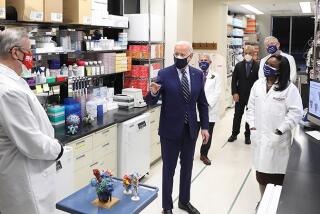The latest bogus attack on Obamacare: It’s anti-innovation!

- Share via
As the Affordable Care Act takes hold as a flag carrier for U.S. healthcare reform, assertions of its deleterious effects become more threadbare and repetitious by the day.
One of the hoariest chestnuts was resurrected Wednesday in a Wall Street Journal op-ed, which purported to analyze Obamacare’s “threat to innovation.” Its author, Scott W. Atlas of the conservative Hoover Institution, called this “perhaps the least noticed” unintended consequence of the ACA. It may be largely unnoticed because it’s largely nonexistent.
Atlas’ op-ed follows the pattern of many other conservative critiques of the ACA. It combines questionable data with irrelevant claims, and blames the ACA for trends that have nothing to do with the act. The heart of the article -- quite possibly its chief motivation -- is an attack on the act’s medical device tax, which is detested by the medical device industry (naturally). As for whether the tax has any effect on “innovation,” that’s a very dubious claim.
Follow along with me:
First, Atlas depicts the Affordable Care Act as a contributor to the declining global competitiveness of American research and development. He observes that U.S. R&D spending has been growing 2.1%, on average, since 2012. Over the last 15 years, he says, U.S. R&D growth has been outstripped by Malaysia, Thailand, Singapore, South Korea, India, the Europen Union and China.
What he doesn’t say is that U.S. spending still outruns the rest of the world. America’s spending of $450 billion in 2013 was far beyond that of its nearest rival, China ($258 billion), according to one of Atlas’ own sources, Battelle. As for most of those other countries, Atlas is exploiting the law of small numbers -- it’s a lot easier to add pennies to pennies than to grow by hundreds of billions of dollars.
Malaysia, for example, is not likely to become an R&D threat to the U.S. any time soon. Its 2013 R&D spending was $4 billion, or 0.8% of its gross domestic product. The U.S. spends 2.8% of its GDP on research and development, near the top of the list.
Atlas also complains that U.S. regulators such as the Food and Drug Administration hinder drug and medical technology innovation by taking so long to approve new products.
This is an ancient complaint of U.S. manufacturers. But it’s not at all clear that the FDA is too strict with its approvals; some critics think it’s too lenient. The question is worth debating, but plainly it has nothing whatsoever to do with the Affordable Care Act.
Let’s turn to the medical device tax, an issue on which Atlas is simply carrying the device industry’s water. The tax, which was one of many imposed by the Affordable Care Act, is pegged at 2.3% of sales of certain medical devices sold in the U.S. It was designed to produce about $30 billion over 10 years, starting Jan. 1, 2013. Certain “devices” customarily provided directly to consumers at retail, such as eyeglasses, hearing aids, sterile bandages and wheelchairs, are exempted.
Atlas parrots the industry’s claim that the tax is prompting companies to move R&D and jobs overseas. This is highly questionable for several reasons. One is that manufacturers have sought to move jobs overseas for decades; the ACA appears to be no more than a convenient pretext for something some companies would do anyway. Furthermore, moving R&D or manufacturing overseas won’t exempt any company from the excise tax -- it’s levied on U.S. sales of eligible devices, no matter where they’re designed or made.
Atlas’ most eye-catching assertion is that “the CEO of one of the largest health-care companies in America recently told me that the device tax his company paid last year exceeded his company’s entire R&D budget.”
This assertion deserves a resounding, “Is that so?” We reached out to Atlas by email with a request that he either identify the company or provide some data that would help us assess or validate this claim. He hasn’t responded; if he does, we’ll update this post.
But a look at the financial reports of some leading medical device companies demonstrates just how hard it would be for a major firm’s medical device tax liability to outstrip its R&D spending -- unless the company is spending so little on R&D it barely counts as R&D at all.
At Medtronic, the world’s fourth-ranked device company, executives have said their bill might eventually reach $175 million a year, which is expected to be the biggest bill in the business. (It was $112 million in fiscal 2014). Medtronic spends about $1.5 billion a year on R&D.
Other companies show similar ratios. Boston Scientific, for instance, said it paid $73 million in medical device taxes last year, when it spent $861 million on R&D.
That’s not surprising, since self-respecting medical technology firms hoping to secure their own futures seem to spend 6% to 12% of sales on R&D. The 2.3% device tax is applied to only a portion of total sales -- eligible products sold in the U.S. -- so a company paying more in the tax than it spends on R&D has to be an extreme case.
If Atlas thinks the medical device tax should be repealed, let’s hear his suggestion about how to make up the revenue; the ACA taxes exist only because conservatives in Congress insisted that the act be revenue-neutral.
Congress tried to spread the pain, levying not only the medical device tax but a tax on generous “Cadillac-plan” health insurance policies, new annual fees on health insurers and pharmaceutical manufacturers, even a tax on indoor tanning services. The rationale for the device tax is that the ACA would also give the industry lots more business. Nevertheless, the medical device folks want to be uniquely exempt from chipping in revenue. This is quintessential special pleading, and it ought to be shunned. We examined the industry’s claims here, and found them suspect in almost every particular.
The truth is that some aspects of the ACA encourage innovation, and some don’t. On the plus side, according to a report by the Clayton Christensen Institute, an innovation think tank, the ACA’s individual and employer mandates will increase demand for healthcare. That should spur research into more efficient ways to deliver better care. This hints at the potential profitability of more R&D in the device industry -- and obviously, provides more patients to serve, at a profit.
The ACA also established the CMS Innovation Center, which will be testing “innovative payment and service delivery models to reduce program expenditures … while preserving or enhancing the quality of care.”
The Christensen report faults the ACA for imposing minimum benefit standards on health insurance plans, but its gripe is that this prevents insurers from bringing “low-end” insurance designs to market. Well, yes; one purpose of the ACA was to wipe out “low-end” plans, because they too often turned out to be deceptive or worthless. The device industry should consider itself lucky in that respect, because a low-end plan would be less likely to pay for a high-end “innovative” medical device.
In summary, Atlas’ critique doesn’t hold together. That’s increasingly typical of anti-Obamacare dead-enders. One would urge them to do better, but this appears to be the best they can do.
Keep up to date with The Economy Hub. Follow @hiltzikm on Twitter, see our Facebook page, or email mhiltzik@latimes.com.
More to Read
Inside the business of entertainment
The Wide Shot brings you news, analysis and insights on everything from streaming wars to production — and what it all means for the future.
You may occasionally receive promotional content from the Los Angeles Times.











